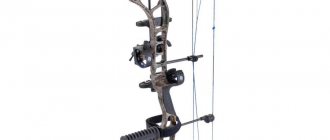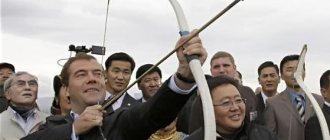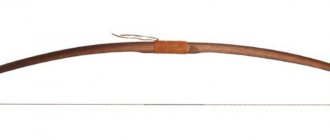How to choose a bow
"- Hello, I went to your website and am choosing onions. Just tell me…” This is how about 90% of calls from people who decide to learn archery or buy a bow as a gift begin. Of course, archery is a good, interesting and exciting hobby. A hobby that develops the muscles of the arms and back, improves the eye and concentration. A hobby that serves as a constant source of good mood, new friends and positive emotions. “What bow do you recommend for me?”
First you need to decide on the goal or ask yourself the question: Why do I need a bow? Based on the answer, we can recommend onions. If you choose a bow to shoot at home or in the country, then any type of bow will suit you, if for sports, then an Olympic or a block, which is closer to you. Or maybe you are interested in archery historical festivals, then you need to pay attention to traditional bows. So, we have three main categories of bows and first we need to choose from them: Traditional bows - these are bows made of wood and glass laminate, have the historical shape of bows of various peoples and the corresponding name, for example Mongolian bow, Turkish bow, English bow, Japanese bow and etc. Traditional bows, in turn, are divided into types: recurve, long, horsebow (short recurve bows). Longbow or longbow - has thick and narrow shoulders with little or no bend. Structurally, it resembles a curved stick, often with a leather-braided handle and a notch for an arrow shelf. The recurve is distinguished by the end of flexible arms (flat and wide), which bend away from the shooter. Due to its design, a recurve bow has a higher initial speed of arrow flight compared to a longbow, with the same string tension. At the same time, the long can be designed with an incomparably greater tension force, and have greater stopping power through the use of longer and heavier arrows. For sport shooting at a standard archery distance of 18m, both types of bows are suitable. Classic bows (Olympic) are close to traditional ones, but are more technologically advanced, allow the installation of additional equipment (sights, balances, etc.), allow the replacement of arms and disassembly for ease of transportation. Compound bows are the most difficult to manufacture, set up, and use. A good compound bow costs at least $400 and requires proper care and basic shooting experience with a classic or traditional bow. However, it is recommended to place your hand on a classic or traditional bow.
Now we select the bow for the shooter
First, we determine the parameters of the bow: Your height affects the maximum length of the bow, your physical parameters affect the tension of the bow (shoulder strength). The length of traditional bows usually ranges from 50-70 inches (125-175cm). When choosing the length, attention is paid only to the ease of handling the bow; for example, for a girl 150 cm tall, a comfortable bow will be in the range of 120-135 cm. When selecting a first bow for those aged 16 years and above, it is recommended to limit yourself to a bow with a draw weight of up to 14 kg. Draw weight is usually stated in pounds (1 lb = 0.45359237 kg) so the first bow will have a draw weight of up to 30lbs. If we have chosen a compound bow, then we need to pay attention to the main parameters - this is the draw and tension force. If the bows are entry level, they have a wide range of adjustments both in power and draw. A great example of this is the Poelang Axis and PSE Stinger bows.
Basic tips:
— Don’t take the most powerful bow, 32-26 pounds is enough to shoot at 30 m, but a bow that is too heavy will not allow you to learn how to shoot correctly. — — Onions should bring you pleasure, so first of all turn to yourself, what exactly do you want.
What to take right away?
Arrows. We will help you choose the ones that match your bow in terms of length and required stiffness. The number of arrows is at least half a set - 6 pieces! To correct shooting, so as not to go to the target after two shots, when at the position it is already clear what correction is needed for the shot, but there are no more arrows. Plus, if you consider that a couple of arrows can be attributed to damage or loss during the first month, it is optimal to purchase a dozen at once. Release - if it is a compound bow, glove or fingertip - for Olympics or tradition. They protect your fingers from rubbing against the string. When firing 50 shots with a bow even weighing 14 kg, an untrained person will develop painful calluses on his fingers; on average, 150-200 shots are fired during training. The gaiter is not a mandatory piece of equipment, but it protects you from possible very sensitive blows from the bowstring on the inside of the forearm. The bow target is large, as large as possible. A target that can ensure that the arrow is confidently immersed in it, without rebounding or penetrating through. Not plywood, not wood, not foam. The most suitable material for this is isolon. If it is mounted on a wall, make sure that there are no fasteners on it that could damage the arrows. A safe place for shooting is a fenced area, without bystanders or spectators on the shooting line. Read a more detailed article about choosing a bow here. Good luck with your purchase and successful shooting!
15.08.2016 15389
go to sections
Related Products
Rolan Snake Bow A high-quality and powerful model of a traditional recurve bow. He has…
Not available
To report
To report
Add to bookmarks
Compare
Bow Alan Bow “Alan” is an excellent choice for those who want to start their journey through t...
1650 UAH
Add to cart Add to bookmarks
Compare
Ragim Matrix 62 bow An excellent example of an Olympic bow is the Ragim “Matrix” bow. He...
2814 UAH
Add to cart Add to bookmarks
Compare
Bow Poe Lang AXIS Initial arrow speed: 310 fps Draw length: 23 - 32″Draw force…
Not available
To report
To report
Add to bookmarks
Compare
Olympic Games winners
Personal competition
| Year | Games | Men | Result | Women | Result | Exercise |
| 1972 | Munich | John Williams (USA) | 2528 | Doreen Wilber (USA) | 2424 | M2 |
| 1976 | Montreal | Darrell Pace (USA) | 2571 | Luann Area (USA) | 2499 | M2 |
| 1980 | Moscow | Tomi Poikolainen (Finland) | 2455 | Ketevan Losaberidze (USSR) | 2491 | M2 |
| 1984 | Los Angeles | Darrell Pace (USA) | 2616 | Seo Hyangsun (Korea) | 2568 | M2 |
| 1988 | Seoul | Jay Barrs (USA) | 338 | Kim Soonyoung (Korea) | 344 | M1+36xM1 |
| 1992 | Barcelona | Sebastien Flew (France) | 110 | Cho Yunjeong (Korea) | 112 | M1+12×70m |
| 1996 | Atlanta | Justin Huish (USA) | 112 | Kim Kyung-wook (Korea) | 113 | 72×70m+12×70m |
| 2000 | Sydney | Simon Fairweather (Australia) | 113 | Yoon Mi Jin (Korea) | 107 | 72×70m+12×70m |
| 2004 | Athens | Marco Gagliazzo (Italy) | 111 | Park Sunghyun (Korea) | 110 | 72×70m+12×70m |
| 2008 | Beijing | Victor Ruban (Ukraine) | 113 | Zhang Juanjuan (China) | 110 | 72×70m+12×70m |
| 2012 | London | Oh Jin Hyuk (Korea) | Ki Bo Bae (Korea) |
Team competition
| Year | Games | Men | Result | Women | Result | Exercise |
| 1988 | Seoul | Korea | 986 | Korea | 982 | 3 x M1 + 3 x 36 x M1 |
| 1992 | Barcelona | Spain | 238 | Korea | 236 | 3 x M1 + 3 x 9 x 70 m |
| 1996 | Atlanta | USA | 251 | Korea | 245 | 3 x 72x70m + 3 x 9x70m |
| 2000 | Sydney | Korea | 255 | Korea | 251 | 3 x 72x70m + 3 x 9x70m |
| 2004 | Athens | Korea | 251 | Korea | 241 | 3 x 72x70m + 3 x 9x70m |
| 2008 | Beijing | Korea | 227 | Korea | 224 | 3 x 72x70m + 3 x 8x70m |
| 2012 | London | Italy | 219 | Korea | 210 |
Names of modern varieties
four types of archery bows professional, traditional, compound and classic.
Professional
It is a high-class weapon that is used during hunting and in sporting competitions.
They must meet the requirements. For example, there are restrictions on attachments.
Professional level weapons are equipped with the maximum number of optional elements: plungers, clickers, compensators and others. Innovative composite materials and technical achievements of science are used.
Traditional
Those bows that are now traditional were used by various peoples before the invention of firearms. In particular, these are Papuans, Indians, Eskimos and many others.
They are created using old technologies: using natural materials (wood, leather, natural adhesives). Traditional bows are not produced on a mass scale. Each product of this type is unique: each of them has its own characteristics and “character”.
Classical
Already used in shooting as a sport. It is also called "Olympic" . The peculiarity of this bow is the double bend of the shoulder (recursive form), which allows you to accumulate twice as much energy for the flight of the arrow.
Another difference between a classic bow and other types is the shelf on which the arrow is held.
Due to it, the end of the arrow with the “feather” does not hit the handle . Natural feathers are no longer used: they are replaced with hard stabilizers, which improves accuracy.
Additional elements began to be installed on sports bows:
- balancers;
- sights;
- vibration dampers and more.
Blocky
It differs in structure from the traditional and classic bow.
Its design consists of pulleys (special blocks) designed to increase the force that is applied to the running end as many times as there are blocks on the bow.
The energy for a shot is accumulated not only in the arms of the bow, but also in a system of cables, one of which is the bowstring. An important feature of the weapon is the “wall” effect. Reset occurs when the maximum force point is reached.
This type of weapon was invented in 1969 by Holles Allen , an American from Missouri. It is not used in the Olympic Games.
Important! This bow can be compared in effectiveness to a firearm, since it is equipped with a sight with a ring frame and a peep-sight (a ring in the string through which a person sees the target).
Problems of choice
When choosing a throwing weapon, they usually focus on compliance with historical truth (aesthetics), combat effectiveness, ease of ownership, and price.
Truth and aesthetics
Many people are drawn to archery by the desire to be like the elf Legolas or other fantasy or historical characters. Although archaeologists have proven the fact that English archers suffered from monstrous scoliosis.
- The most reliably repeating the contours and design of traditional bows are products from the Samik company (pr. Deer Master). The handle is made of laminated solid wood, and the removable arms are laminated, with an external plastic coating. The only thing that can be installed on them without damaging the structure is a shelf, which allows you to use arrows not only with natural feathers. The Optimo model from SF (Sebastian Flute) is similar to them. Mongolian bows from Interloper and Supermag are also good.
- Real Olympic recurve bows are made by SF. The series starts with the Axiom model. They have an aluminum handle on which you can install a sight, balancer, plunger, or shako. This is a transitional option between tradition and classic: their shoulders are laminated - wood, covered with plastic. There are options for classic bows, made entirely of modern materials. For example, the Blue Knight Bow (Olympic), which has fiberglass arms and an aluminum handle.
- Compound bows have an industrial aesthetic and are an arrow-throwing machine.
This video will tell you how to choose a bow for a novice archer for hunting:




